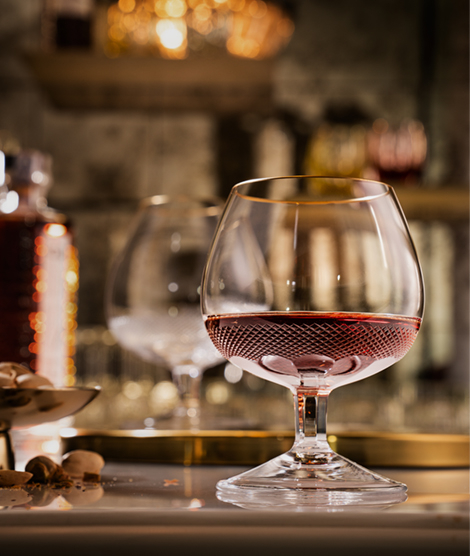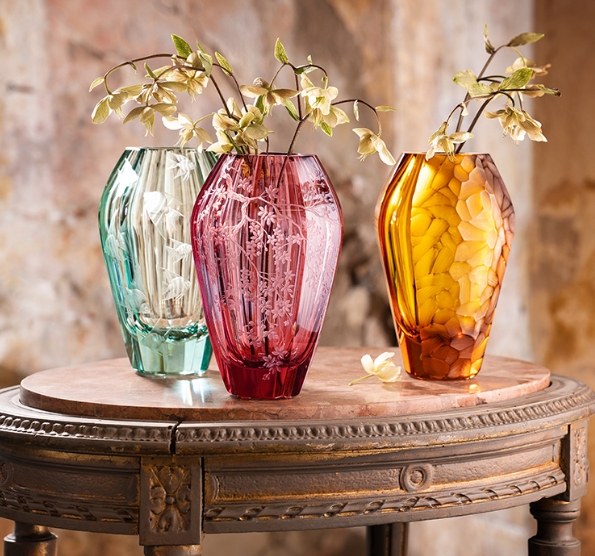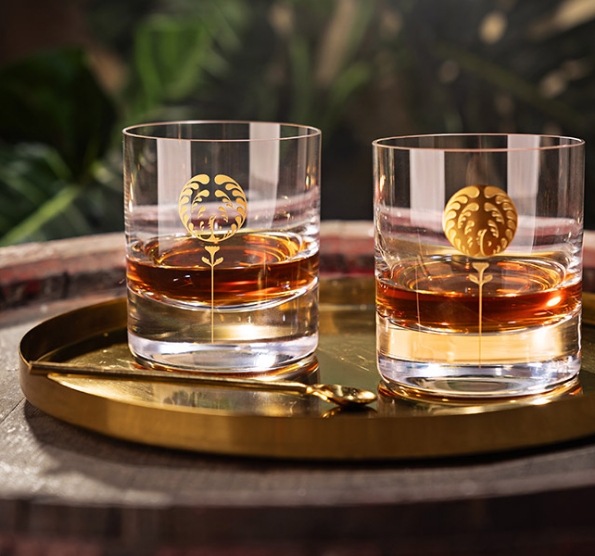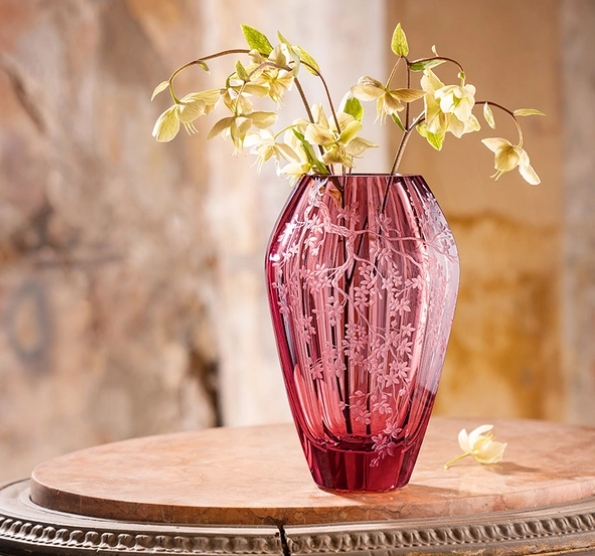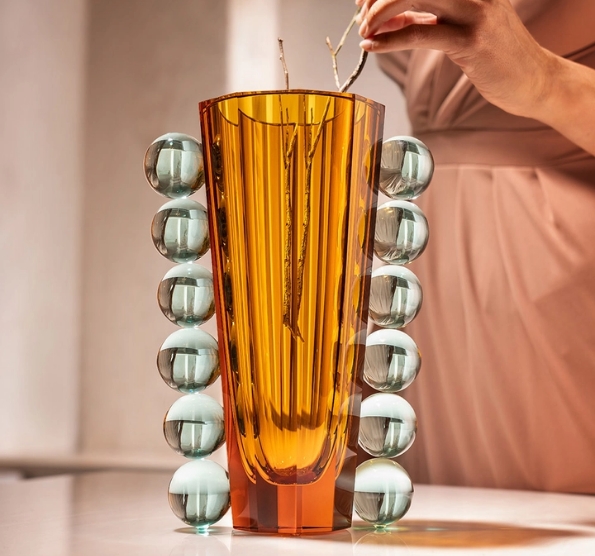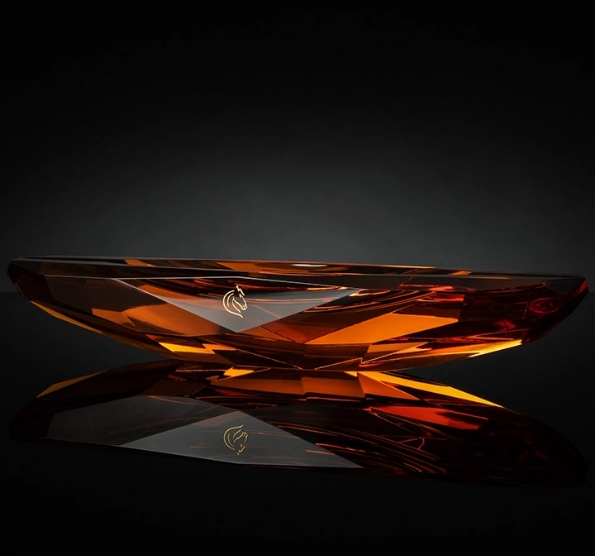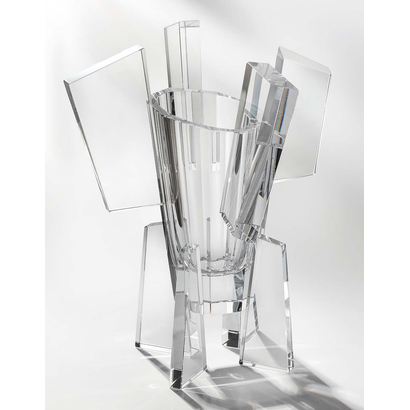Breadcrumbs navigation
- Home page
- About Moser
- Blog
- The icon of Czech design. How did the artist René Roubíček influence Moser?

The icon of Czech design. How did the artist René Roubíček influence Moser?
He viewed glass as the art of today. He believed it could speak for itself and all he needed to do as a designer was to give it space to do so. This is how the legendary artist René Roubíček, who would have celebrated his 100th birthday this year, approached glassmaking. At the beginning of the millennium, he also started collaborating with Moser, for which he designed several limited collections. Why is he called the icon of Czech design?
“We were so excited that we have finally freed ourselves and we were going out into the world. That we can show off and that we have all it takes. And I think we didn’t let ourselves down. It wasn't bad,” René Roubíček said a few years ago in an interview for the programme Memory of the Nation. He was speaking about the EXPO 1958 exhibition in Brussels, a major milestone for Czechoslovak design and architecture. Roubíček's abstract sculpture titled Glass - Matter - Shape - Expression became a manifesto of modern approach to glass – not only in design. His artworks were characterized by a variety of shapes and an abundance of colours.

Visionary approach and timelessness were distinctive attributes of the artist’s works. The same can be said about his partnership with Moser, which began in 2006. Tomáš Ritzer, the head of the Moser studio, recalls: “I remember how we sat over his designs from an early morning, trying to refine the specific parts. It was only after a rather long preparation that we settled each wedge and stuck it in place. With hindsight, I began to understand the art, order, and meaning with which Mr. Roubíček attached individual cut blocks of various shapes onto vases.” Which other attributes made René Roubíček unique both as a personality and an artist?
Not to be bound by traditions
René Roubíček had been surrounded by art and culture ever since his childhood. He was born on January 23rd, 1922, in Prague. He inherited an absolute pitch and love for music from his father, who was a professional musician and worked at the Oldřich Nový Theater. He also enjoyed acting, reciting alongside his older brother in Disman's Radio Children's Ensemble. But in the end, he used his talent primarily in drawing and art. When he was only 14, he organized his own exhibition. Even the painter Max Švabinský was one of his supporters.
Due to the Second World War, during which the Academy of Fine Arts closed, Roubíček eventually joined the Studio of Glass and Monumental Painting at the School of Arts, Architecture and Design in Prague. Thanks to Professor Jaroslav Václav Holeček, he started working with glass, even though he did not know much about the medium back then. "There were people in all fields who wanted to do freelance work, but it was not possible at the time. So the part of my generation that manifested itself in glass was not bound by traditions,” Roubíček explained in an interview for Lidové noviny.

After graduating, René Roubíček worked, for example, as the leading artist of the national company Borské sklo and he had a significant role in establishing glassmaking as an artistic craft. The EXPO 1958 in Brussels was a turning point from which Roubíček gained not only his fame, but also a Grand Prix for the aforementioned composition Glass - Mass - Shape - Expression. The sculpture, made of wrought iron and molten glass, stretched into space, resembling an unusual, coloured statue.
During his professional career, he also celebrated success at the Montreal EXPO in 1967 and three years later in Osaka. Among other, Roubíček's major works include an assembly of columns named Returning to Europe, which was inspired by the ancient Greece. In the very beginning of the 1990s, this statue referred to the Velvet Revolution in Düsseldorf. His chandeliers and other works decorated the Czechoslovak embassies in Washington, London, and Sofia.

Kind and cautious person
René Roubíček partnered with Moser, which was established in 1857, on the occasion of the brand’s 150th anniversary. “Even during the partnership, we viewed him as a legend and one of the main icons of Czech design. He was a very kind and cautious man. He paid us regular visits, sometimes even for a few days, together with his then little grandson Petr,” Tomáš Ritzer, the head of the Moser studio, recalls. Even towards the end of his professional career, the artist’s work was unique in his distinctive approach, precision, and unprecedented sense of detail. “Roubíček's conception of design was ground-breaking, just look at the elaborate attachments on his vases, or the sculpture named Buddy,” Ritzer adds.

The limited editions that originated from this unique collaboration have aroused great interest ever since 2007. Some of the rare pieces are still available. And it seems that René Roubíček's name will be associated with Moser forever. "During production, various derivatives or completely unique versions of already existing works are created. We are now working on new objects based on Roubíček's designs that never went into series production,” Tomáš Ritzer reveals. He also stresses that his colleagues always like to reminisce about René Roubíček, who died at the age of 96 in the spring of 2018. Without exaggeration, Roubíček belongs to the fathers of modern glass art.

René Roubíček,
glass artist and designer
(January 23, 1922 - April 29, 2018)
He was one of the most prominent representatives of Czech glassmaking. Apart from the careful attention to detail, Roubíček's work is characterized by optical effects, playful geometry, and an emphasis put on the coordination of colours. Roubíček was born in 1922 and he had been interested in drawing and music ever since he was a child. Thanks to Professor Jaroslav Václav Holeček, he eventually started working with glass at the School of Arts, Design and Architecture in Prague. His works have attracted attention at EXPO shows in Brussels, Montreal, and Osaka. According to Roubíček, the first of the exhibitions, which took place in 1958, was a major turning point thanks to which Czechoslovak artists were finally able to show themselves to the world. In Brussels, the artist won the highest Grand Prix for his abstract composition Glass - Matter - Shape - Expression. His wife Miluše Roubíčková was also an important Czech artist and designer. In 2006, René Roubíček partnered with Moser – he prepared a limited collection on the occasion of the brand's 150th anniversary. The partnership lasted for over five years and gave rise to, for example, the unconventional Buddy sculpture and the Galaxy bowl. A new version of the Blues vase, originally designed by René Roubíček in 2013, is one of this year's Moser novelties. The yellow-green work, which reflects the beauty and energy of Moser crystal, will be available in a limited series of 50 pieces.
